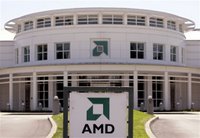AMD + ATI
 With all the hubbub surrounding the Core 2 from Intel, some of you may have missed out on the bigger news in the industry: AMD is planning to buy ATI in a $5.4 billion purchase. If you look even just a little out there, you'll see that this deal was recently approved by AMD's stockholders, and pending SEC approval, it looks like it is good to go.
With all the hubbub surrounding the Core 2 from Intel, some of you may have missed out on the bigger news in the industry: AMD is planning to buy ATI in a $5.4 billion purchase. If you look even just a little out there, you'll see that this deal was recently approved by AMD's stockholders, and pending SEC approval, it looks like it is good to go.Actually, even if you've been following the Core 2 launch yesterday, you will have no doubt heard of the emergency revamping of machines from ATI graphics to NVIDIA graphics. There was supposed to be an ATI Crossfire exhibition right on stage using the Intel Bad-Axe motherboard, however early this week those machines were pulled. You really can't blame Intel, the media would blow it up.
What's more interesting to me about the merger is the direction that AMD will move with the addition of GPU's and high-performance chipsets to their line up. Back in January, I wrote about the return of the co-processor. In that article, I said that we would begin to see field programmable arrays that could fit into the standard Opteron socket to speed up things such as Java applications. We have indeed seen that happen, and Cray has announced a super computer using a mix of FPGAs and Opterons.
Of course, how many of us use multi-million dollar supercomputers? I went on to describe how the movement would affect the average consumer. I talked of NVIDIA creating chips to accelerate TCP/IP interactions and encryption, or rendering chips to accelerate CAD and 3d modeling. I still think this is in the works, however it may be an ATI product now.
Then onto the standard desktop. I can see that in just a few years there will be the option to use socketed graphics chips, physics chips, audio/video processors or network accelerators in the home machine. The beauty of these chips will be their ability to be upgraded. No more having to buy an entire PCB, complete with power management features, memory, and all the headers and the like. You can just buy the chip and swap it out on a board.
What this has to do with the merger is that since AMD has access to Hypertransport, so does ATI. AMD is already talking heavily about multi-socketed motherboards with their 4x4 initiative, and it will not be difficult to make an ATI physics processor for gaming. As usual, everything will start in the enthusiast market and trickle it's way down to the home user.
Overall, I'm very excited about the future of computing. Windows Vista is a huge change from XP, and any time you have such an impressive change, you will have hardware adapting to best utilize what's available. It's a great time to get into computers!












